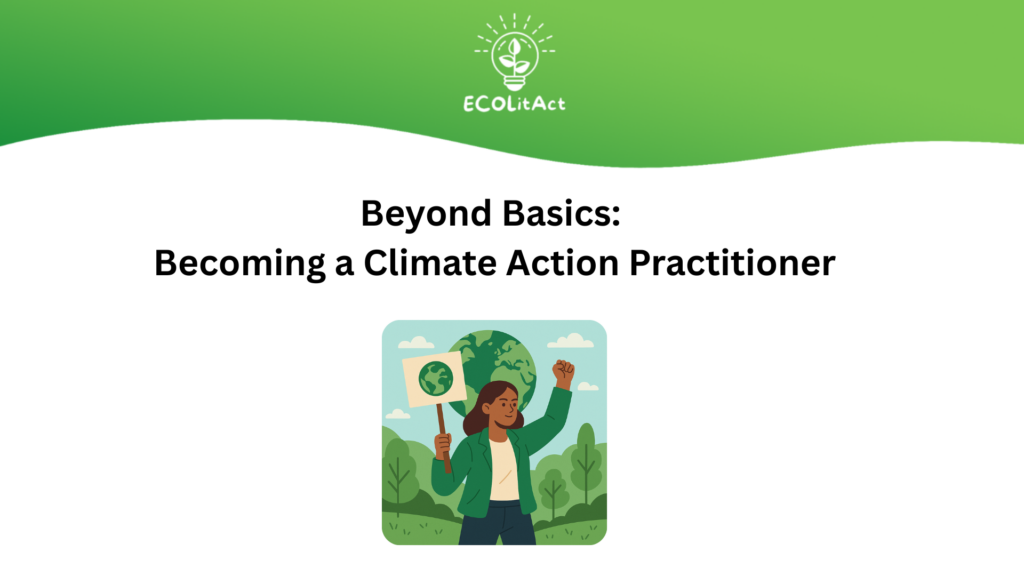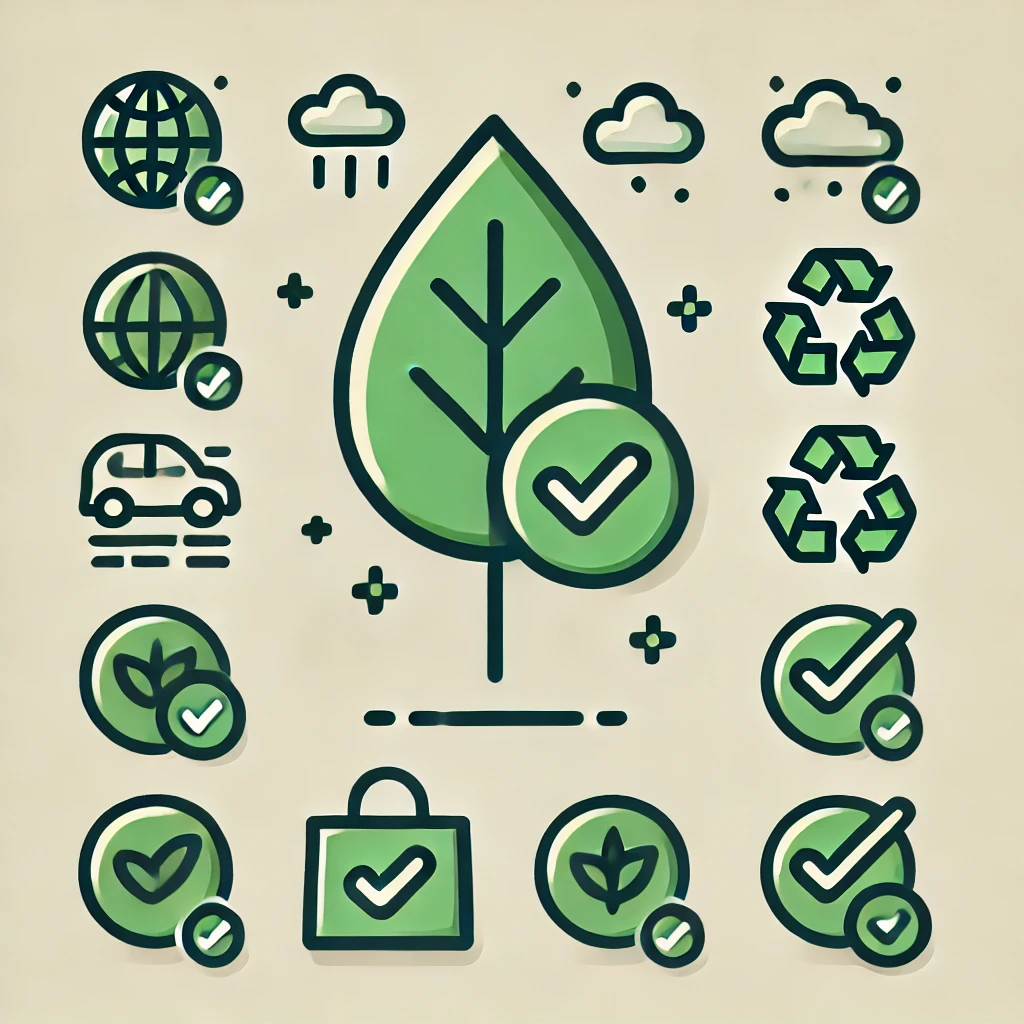Introduction and Learning Objectives | Vocabulary | Video Case Study: What Kind of Activist Are You? | Understanding Greenwashing in the Real World | Activism in Action – What Works, What Doesn’t? | Take Action: Design Your Own Activism Plan | Final Quiz | Conclusions | Europass
Welcome to the Practitioner-level module on Climate Activism.In this module, you’ll move beyond learning about climate change—you’ll explore how to respond to it through informed, ethical, and effective action.
You’ll investigate different forms of activism, evaluate real-world tactics, and begin developing your own activist voice. Whether you want to raise awareness, challenge misinformation, or launch a community initiative—this module will help you build those skills.

Learning Objectives
By the end of this module, you will be able to:
- Recognize different types of environmental activism and their purposes
- Identify and critique greenwashing in media and advertising
- Use digital tools to educate and advocate for environmental issues
- Reflect on the ethical dimensions of activism
- Create an individual action plan aligned with your personal values
Lesson Duration:
This lesson is self-paced and designed to be completed in approximately 2 hours.
Learn the Vocabulary!
Before you dive into the lesson, take a moment to explore the vocabulary we’ll be using. Understanding these key terms will help you follow the materials more easily and talk about activism with confidence.
Use the dialogue cards below to learn important words and concepts connected to climate action.
Flip each card to see what the term means — and try to remember it!
You’ll see these words again as we go deeper into the topic.
Video Case Study: What Kind of Activist Are You?
Before jumping into action, it’s helpful to explore what activism looks like in real life. In this video, you’ll meet young people taking climate action in different ways. From organizing cleanups to raising their voices online, these youth show how activism can be creative, personal, and powerful.
Questions for Reflection
- What type of activism feels most meaningful or accessible to you?
- Have you seen similar activism in your community or online?
- What would your first steps be if you wanted to take action on a local climate issue?
Drag the Words – What Kind of Activist Are You?
Drag the correct word into each blank to complete the sentences. All answers are based on the ideas shared in the video.
Now you know…
- How misinformation affects public views and policy decisions about climate change.
- How to spot fake news and use credible sources to verify climate-related information.
- Ways to collaborate with others to address and counter misinformation in your community.

Action point:
You can work individually or in groups to analyse real-world examples of climate misinformation and develop a strategy to address them. Use what you’ve learned in this video as inspiration.
Hint: focus on something close to your community or daily life to make your plan more relatable and effective.
Understanding Greenwashing in the Real World
In this section, you’ll learn to identify greenwashing—when companies make misleading claims about how environmentally friendly their products or practices are. You’ll explore common tactics, learn why greenwashing is harmful, and practice spotting it in real-world examples.
Interactive Quiz – Greenwashing True or False?
Discover your eco-conscious decision-making skills with this True/False exercise on reducing the impact of shopping.
Test your understanding of greenwashing with this quick true/false quiz.
✅ Greenwashing Checklist
🔍 Is it clear why the product is “green”?
→ Look beyond slogans, green colours, eco-style packaging, and vague claims.
🌐 Can you find more information?
→ Check if there’s a website or other source that backs up the environmental claims.
🧾 Does the claim reflect the whole product?
→ Make sure it’s not just highlighting a “green” detail while ignoring other harmful aspects.
🍏 Is the claim relevant?
→ Ask yourself: would the claim apply to any product like it? (e.g., saying an apple is “plant-based”).
♻️ Is the product easy to dispose of sustainably?
→ Look for recyclability, compostability, or other eco-friendly disposal options.
Case Study Activity: How to Spot Corporate Greenwashing
Now that you’ve learned the basics of greenwashing, let’s take it further with real-world examples. This activity is based on a fact-check investigation of popular green claims made by companies like H&M, McDonald’s, and Coca-Cola.
You’ll watch a short video, then complete a reflection and answer fact-based questions to sharpen your ability to critically assess environmental messaging.
Reflect:
📝 After watching the video, consider:
- What type of greenwashing did H&M use?
- Why might vague claims be especially harmful in advertising?
- What is “lateral reading,” and how can it help you verify environmental claims?
Activism in Action – What Works, What Doesn’t?
Activism can take many forms depending on the goal, the urgency of the issue, and the values of those involved. In this section, you’ll explore a video that shows examples of radical climate activism in action, and reflect on what makes activism powerful, ethical, or controversial.
Reflect:
- What methods do the activists in the video use to get their message across?
- Do you think these actions are effective? Why or why not?
- What risks or challenges do they face?
- Can you imagine taking part in something similar? What would you do differently?
Radical vs. Institutional Activism
Below you’ll find a breakdown of the two approaches:
🚧 🟥 Radical Activism
- Seeks rapid and visible change
- Often uses direct action (e.g., protests, occupations)
- Challenges systems seen as unjust or slow-moving
- May involve civil disobedience
- Examples: blocking fossil fuel infrastructure, mass mobilizations
🏛️ 🟩 Institutional Activism
- Works within existing political or social systems
- Focuses on gradual policy reform and legal action
- Engages with governments, NGOs, or institutions
- Examples: lobbying, campaigning, community outreach
Both forms of activism are valid and often complement each other. Understanding the context and goals helps activists choose the most effective approach for their cause.
Test your understanding of radical and institutional activism with these quick True/False statements. Decide whether each statement is true or false based on the concepts discussed above.
Reflect:
- Do you agree with the tactics shown? Why or why not?
- What makes activism ethical or effective?
Now you know…
- The difference between radical and institutional activism, and when each approach might be most effective.
- That both styles of activism—though different in strategy—can contribute to real, lasting change.
- How to critically evaluate actions and campaigns through an ethical lens and based on their impact.
Take Action: Design Your Own Activism Plan
What you will do:
Now it’s your turn to put knowledge into action. Use this activity to design a personal or community-focused activism plan. Choose a climate or environmental issue that matters to you, and outline how you would address it through meaningful activism.
This can be a digital campaign, a local awareness initiative, or a personal behaviour change challenge. Your plan doesn’t need to be big to make a difference—it just needs to be realistic and driven by purpose.

Instructions:
- Identify a climate-related issue you care about (e.g., greenwashing, plastic waste, climate misinformation).
- Choose the style of activism you’d like to use: radical, institutional, or a combination.
- Outline the goal of your activism: What change do you hope to see?
- Describe the steps you’ll take: What actions will you carry out? Where? How?
- Decide how you’ll share or communicate it: Will you use social media, posters, a blog, or conversations?
- Reflect on challenges you might face and how you could overcome them.
Your action plan should include:
- A catchy campaign title to grab attention
- A clear definition of the issue you’re addressing and why it matters
- Your key message: what you want people to understand or do
- The platform(s) you’ll use to reach your audience (e.g., social media, posters, blog)
- One concrete action your audience should take after seeing your campaign
What will you gain:
- Strengthen your ability to think critically about activism strategies and choose appropriate methods for your goals
- Gain hands-on experience in creating an effective campaign plan and identifying your communication tools
- Build confidence in taking initiative independently while considering the social impact of your actions
Final Quiz: What Have You Learned About Activism?
You’ve now explored the core principles of climate activism and how to take real-world action. This quiz will challenge your understanding and readiness to apply what you’ve learned in a practical context. Answer the multiple-choice questions to evaluate your take of the material and to further sharpen your activism skills!
Well done!
You’re now finished with the Practitioner level on Climate Behaviour & Activism!

If you would like to learn more about how you can take action and actively support positive changes in environment, you can check more resources here!
Showcase your new skills with Europass
You have just completed another step in your learning journey. The skills and knowledge you have gained are valuable – not just for countering climate denialism and contributing to a greener future, but also for opening doors to new opportunities for you! A great way to do this is by adding them to your Europass profile.
Europass is a European Union initiative that helps individuals communicate their skills, qualifications, and experiences clearly and effectively. It consists of several documents, including the Europass CV, which is recognised across Europe and beyond, making it easier for learners to present their qualifications to potential employers or educational institutions.
If you don’t yet have a Europass profile, creating one takes just a few minutes. Get started here. And if you need a little help to set things up, you can take a look at this video tutorial.
For the lesson you have just completed, we encourage you to add the following skills:
- Promotion of informed consumer behaviour through evidence-based communication
- Integration of sustainable practices into personal and community initiatives
- Critical analysis of environmental information, including detection of misinformation and greenwashing
- Evaluation of environmental activism methods, including ethical and historical considerations
- Digital and creative communication for environmental advocacy and public engagement
